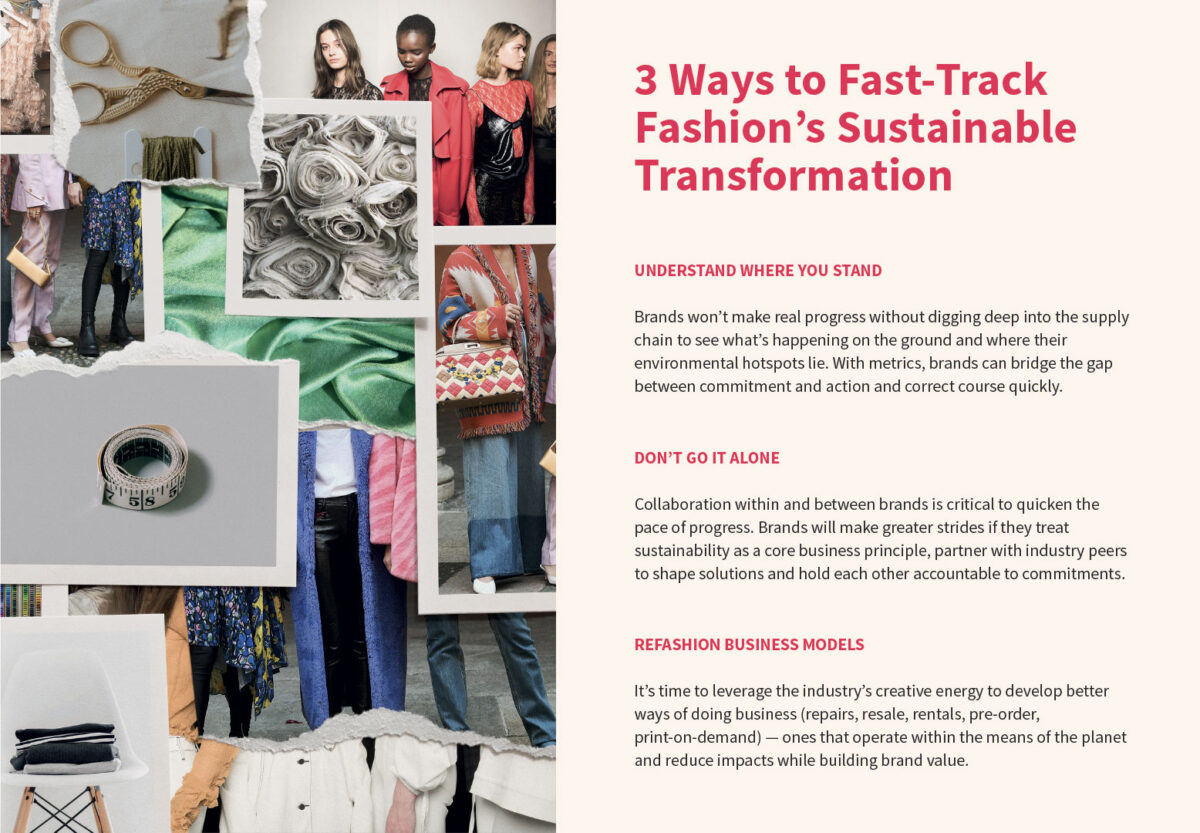You can’t have a conversation about fashion these days without touching on the topic of sustainability. The industry’s environmental impacts — from greenhouse gas emissions to microplastics, biodiversity loss and water ecotoxicity — are now well-known by consumers and companies alike. But awareness isn’t enough. All eyes are now on brands to usher in a new era for fashion, one where industry operates within the means of the planet.
So, how are they measuring up? Spoiler alert: far from good enough. Over the last few years, the number of companies committing to set science-based targets, and multi-stakeholder initiatives have skyrocketed. A number of coalitions such as Fashion Pact, the United Nations Fashion Industry Charter for Climate Action, Make Fashion Circular and Fashion Conveners have formed to tackle the industry’s impacts on climate, biodiversity, land-use change and more. It’s an encouraging sign and a step in the right direction, but in this decade for action, good intentions are simply not enough.
The fashion industry is on the verge of a climate revolution, but action is getting bogged down by semantics and distracted by low-hanging fruit.
Given the scope and speed of change needed to transform fashion, the follow-through — translating these good intentions into tangible actions with meaningful impact — is where brands are falling short. Even before the coronavirus pandemic hit, the industry’s slow progress was starting to raise eyebrows.
5 challenges slowing the pace of improvement
What’s keeping brands from leaping into action isn’t complacency. The slow pace of improvement is largely linked to these five common pitfalls:
- Sustainability still isn’t seen as a top priority. Fashion execs predominantly see sustainability as a cost rather than a value driver — a gateway to new business opportunities and reduced risk. When viewed through this lens, sustainability is made a fringe activity, separate from core business processes such as strategy, governance, marketing, design and development and operations. The focus is on compliance and efforts that don’t disrupt business as usual, rather than actually tackling significant risks and impacts.
- There’s no clear vision about what it means: Sustainable, circular, resilient — this is what consumers and investors are asking apparel brands to be. But there’s a big gap between where stakeholders expect companies to be and reality. That’s a problem. A surprising number of brands still don’t have clarity on what sustainability means in practice and use the latest buzz to guide sustainability efforts.
- There’s too much focus on low-hanging fruit. Brands are often tempted to turn to quick fixes, such as offsets, to yield wins in the short term, but these makeshift solutions are unlikely to have a big impact on business sustainability. Certification schemes for raw materials are another example. Brands rely on certifications to demonstrate improvements made within their supply chains, but this can be misleading. A certified material doesn’t necessarily equate to impact improvements. Focusing energy and resources on incremental interventions that do little to address the root cause of key impacts will make it harder for fashion brands to carve out a credible path to sustainability and build business resilience in the long run.
- Details are getting in the way of action. Is the industry’s contribution to global GHG emissions 5%, 8% or 10%? Are the environmental impacts of microplastics included? Does sourcing 30% recycled polyester reduce our impact by 2% or 4%? All too often, fashion brands let what they don’t know prevent them from acting on what they do know. They can already accomplish a lot with the tools and data available today. There is sufficient data available to make intelligent decisions and take meaningful action in their supply chains, even as efforts to improve knowledge continue.
- Efforts are often siloed. The scope and complexity of the issues fashion brands must tackle requires a collective response to drive real progress at the pace needed for long-term change. Multi-stakeholder sustainability initiatives have moved from fringe to mainstream at breakneck speed as brands begin to see the value of collaboration in solving shared challenges. Yet within companies, sustainability efforts aren’t always embedded into every aspect of business. Lack of communication and coordination between teams can undermine or slow the pace of improvement, as well as create chaos and additional work.A classic example: the creative team designs a sustainable product, but then the purchasing team can’t find the right suppliers to source the materials needed to produce it. The operations team then has trouble meeting the production schedule, and the sustainability team blocks the process to verify everything is being done correctly. And then, when the product is almost at the finish line, retail says it’s not on board, so the products will not be marketed to the potential customers as sustainable.
3 ways to fast-track fashion’s sustainable transformation
There is no vaccine for climate change, and fashion brands must shift gears quickly to mitigate adverse effects on their supply chains and keep up with rapidly changing stakeholder expectations, values and behaviors. Here are three ways fashion can get on the fast track:

- Understand where you stand
There has been a massive wave of climate, deforestation, biodiversity and plastic commitments by the fashion industry in recent years but not much to show for them. One major reason: Companies are making commitments without doing the necessary foundational footwork — the vast majority of fashion brands haven’t done a corporate footprint nor do they know where their materials or textiles originate. Without this information, brands can’t know if the goals they’ve set are relevant for their business, how to achieve them or what their implications are.
For example, more brands are announcing 100% sustainable fiber targets for 2025, yet less than 10% of the world’s 250 largest fashion brands and retailers can identify their tier four suppliers. Delivering on this goal will be a colossal challenge without a process to trace garments to their origins.
With the majority of fashion’s impacts situated in Scope 3, it will be impossible for brands to make real progress on goals without first digging into the supply chain and understanding what is happening on the ground — where their hotspots and drivers of environmental impact lie.
Greater transparency in the supply chain isn’t a silver bullet, but it is an important step in driving fashion industry transformation. It can improve accountability by shedding light on the conditions in which clothing is being made, allowing suppliers, brands and retailers to make improvements quickly and collaboratively. It can also create incentives for companies to make meaningful changes to their current practices and spark new innovations.
- Don’t go it alone
Sustainability starts from within, but sustainability teams often find themselves fighting an uphill battle to make even the smallest of changes happen. Rather than treating sustainability as a separate, disconnected topic, brands must start treating it as a core business principle. That means embedding it into the heart of business strategy so it can trickle down into every aspect of business such as design, development, sourcing and marketing.
Engaging teams on sustainability and helping them understand how they each contribute to the company’s sustainability goals and who they need to collaborate with to make things happen is critical for breaking down silos and quickening the pace of progress. (Check out how Gore-Tex, the Gore Fabrics Division, is engaging its teams to achieve its ambitious carbon goals.)
Companies will also make greater strides if they look beyond their own four walls. Teaming up with other companies and partners across the value chain to share ideas and shape solutions allows the industry to overcome shared challenges faster and clears a pathway for industry peers that aren’t as far along on the sustainability journey.
For collaborative initiatives to be truly effective, however, they must hold companies accountable to their commitments. Very few do so, with little to no consequences for brands that fall short of the mark. Publicly reporting on progress and government policies requiring companies to substantiate environmental claims have important roles to play in holding companies to their commitments by putting brand credibility on the line. The development of Product Environmental Footprint Category Rules for apparel and footwear, which are currently being developed, will enable a level playing field when it comes to how product footprinting is conducted and how impacts are communicated.
However, investors and shareholders are likely to move the needle forward faster, placing ever-growing pressure on companies to provide information about their environmental risks and proof of the actions being taken to build resilience. Brands that start piecing together this picture now will be in a much better position when they come knocking.
- Think outside the box
We can’t get off the destructive path we’ve been on and build a resilient future for fashion by applying the same sort of thinking that got us here in the first place. Yet many solutions being put forth simply plug into the prevailing retail model, upholding the idea that sustainability can be bought and sold, rather than tackling the root causes of the problem — overproduction and overconsumption.
Fashion has always been a hotbed for innovation, as well as a catalyst for social change; it’s time to leverage the industry’s creative energy to design better business models — ones that operate within the means of the planet rather than a take-make-waste approach. These could include rental, resale and repair schemes; pre-order models of production, print on demand and a departure from the traditional seasonal cycle; and a greater emphasis on product quality and durability, which is often compromised to fuel the industry’s unsustainable business model.
Digitalization also has a significant role to play in improving industry agility and efficiency. Digital technologies can enable brands to order and manufacture on demand, better predict consumer trends, increase accuracy of stock forecasting and improve supply chain traceability.
There’s a lot of work to do and the clock is ticking. The good news is that sustainable transformation is well within our reach. But we need to keep the momentum going. With a bit of creativity and collaboration, we CAN get there.



